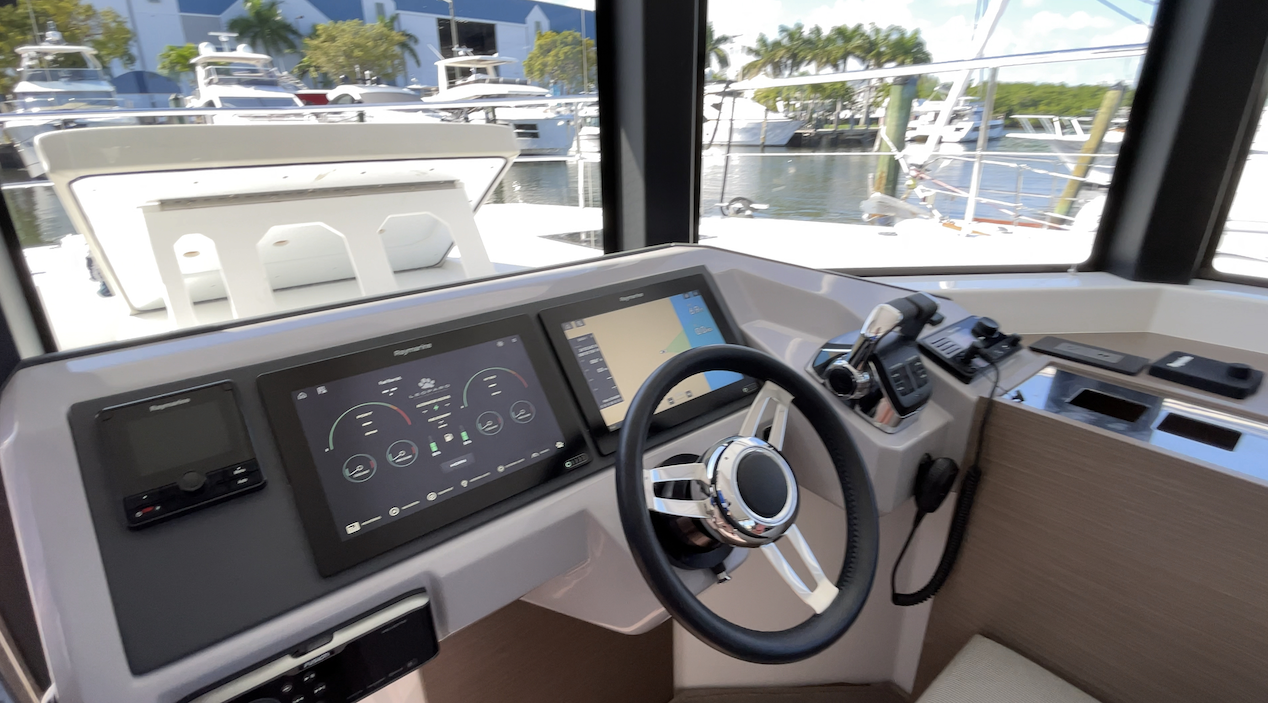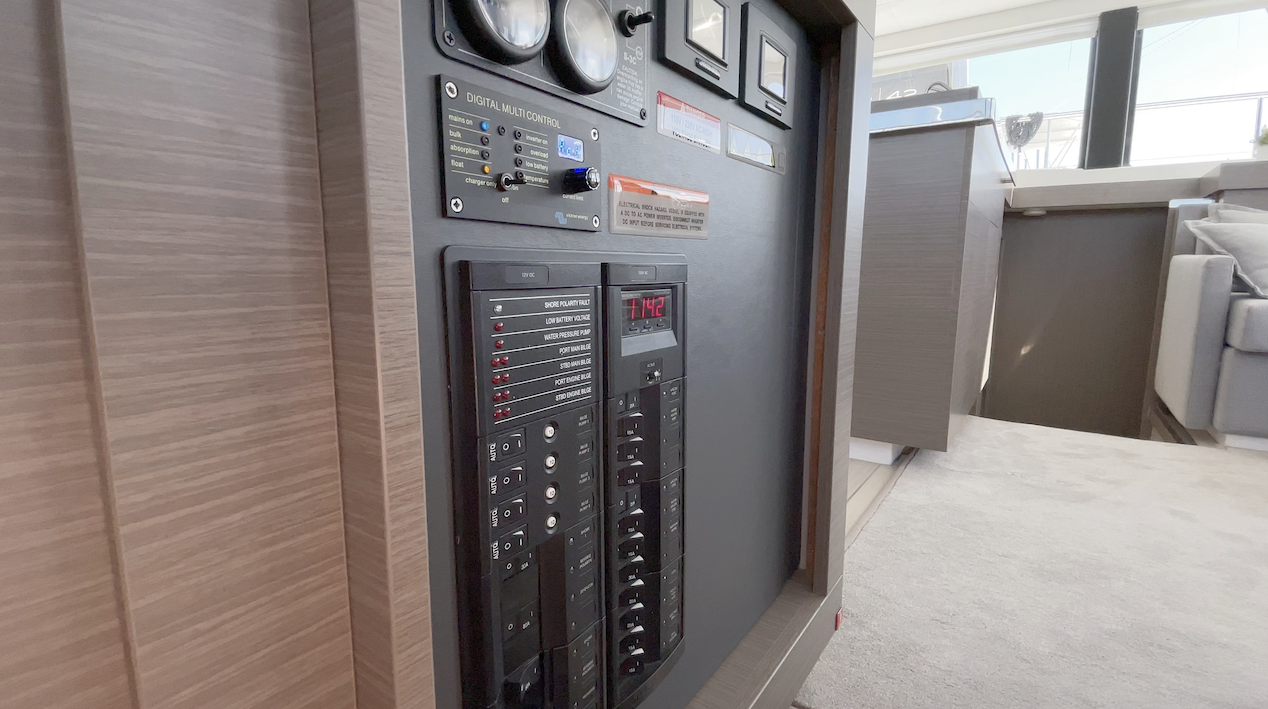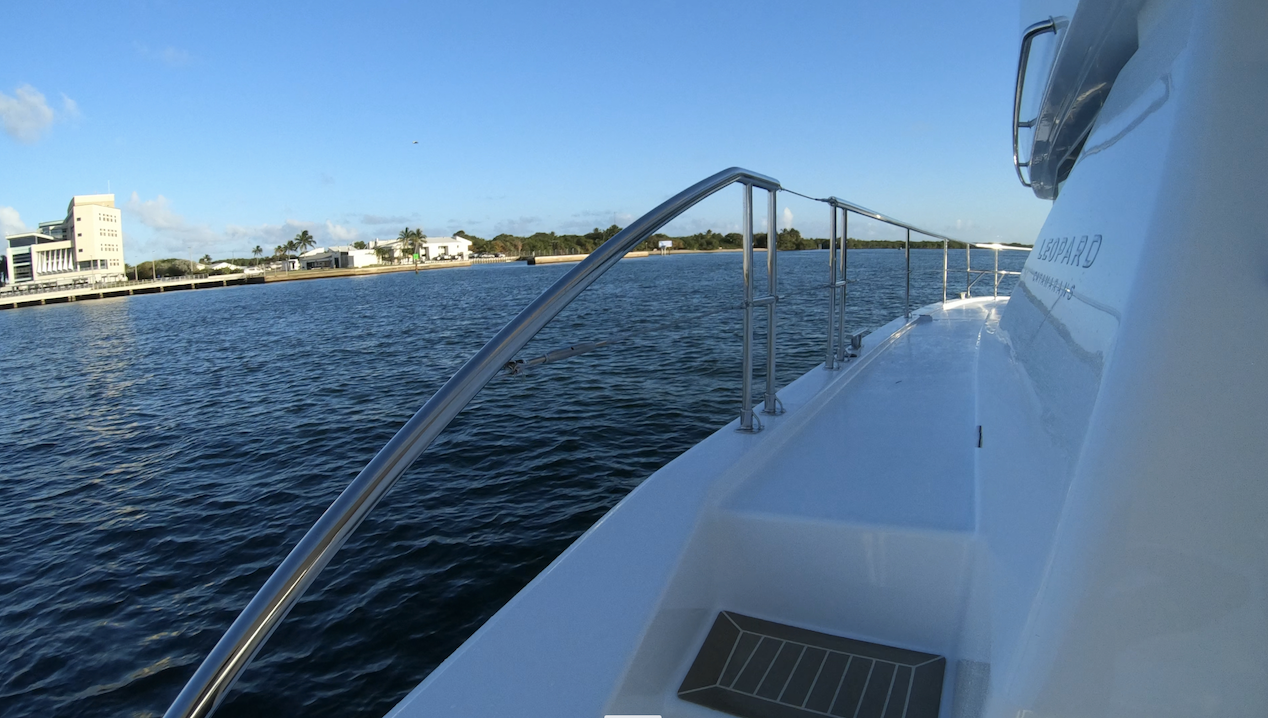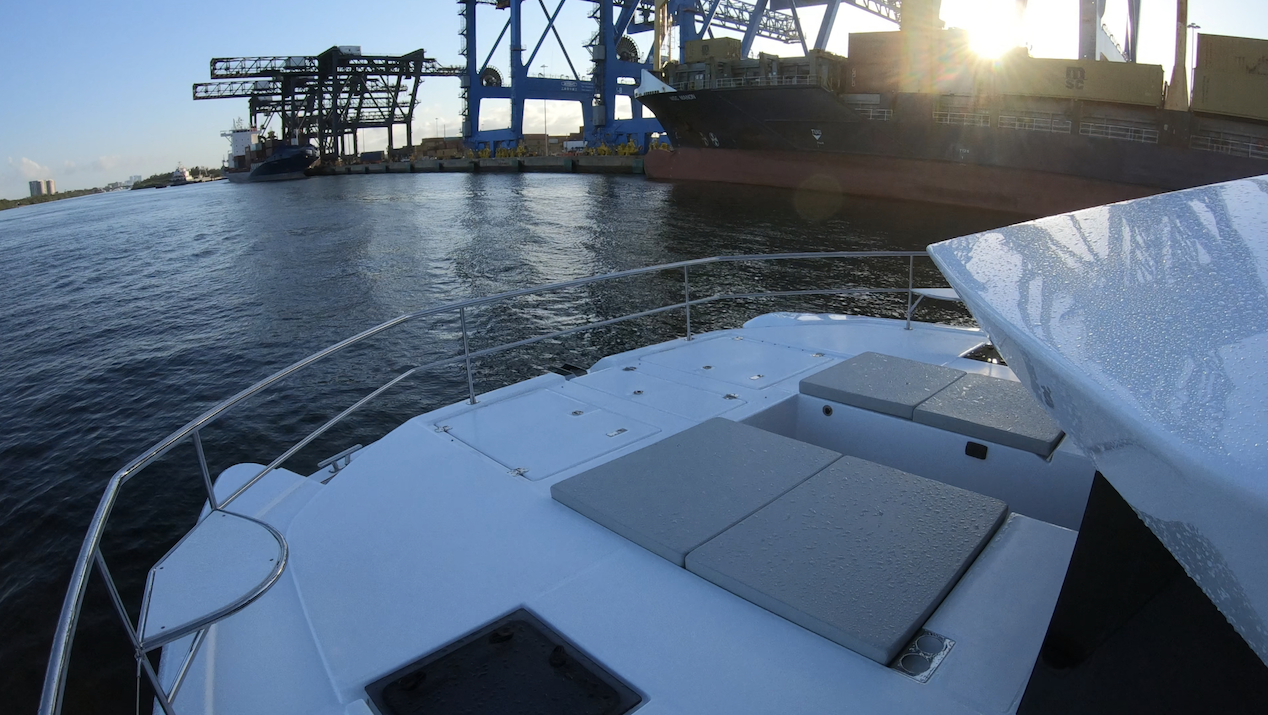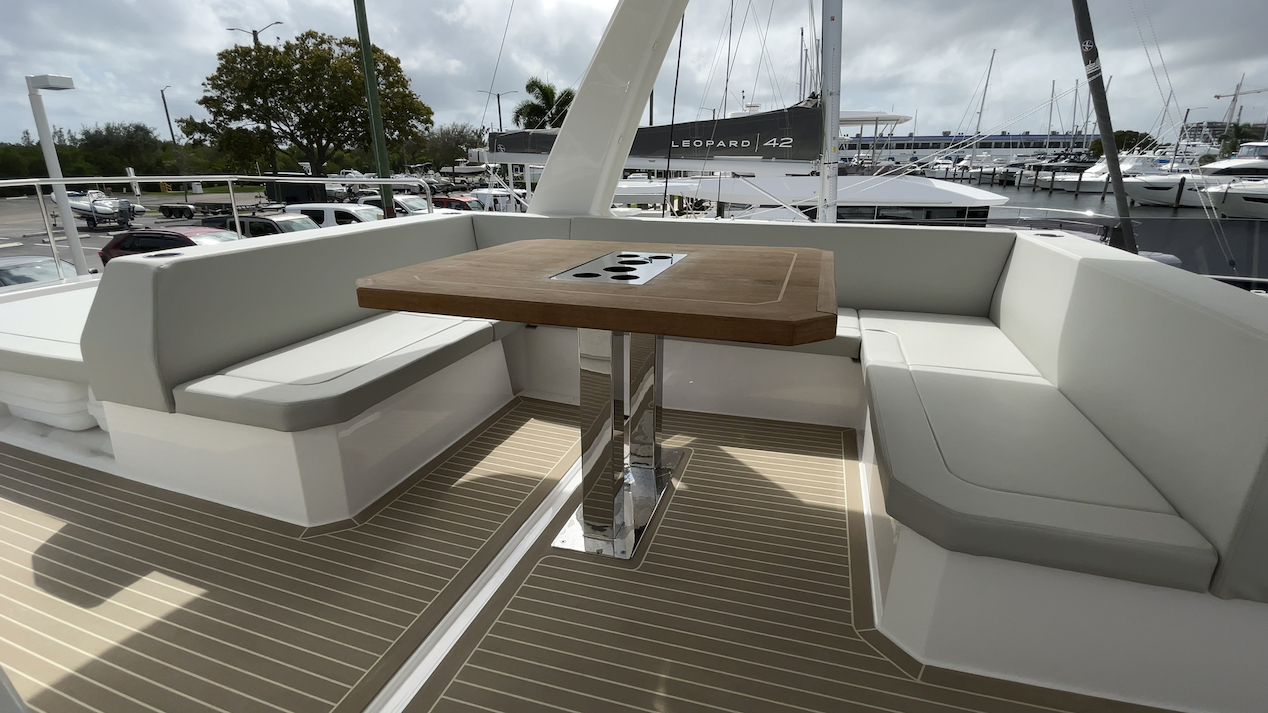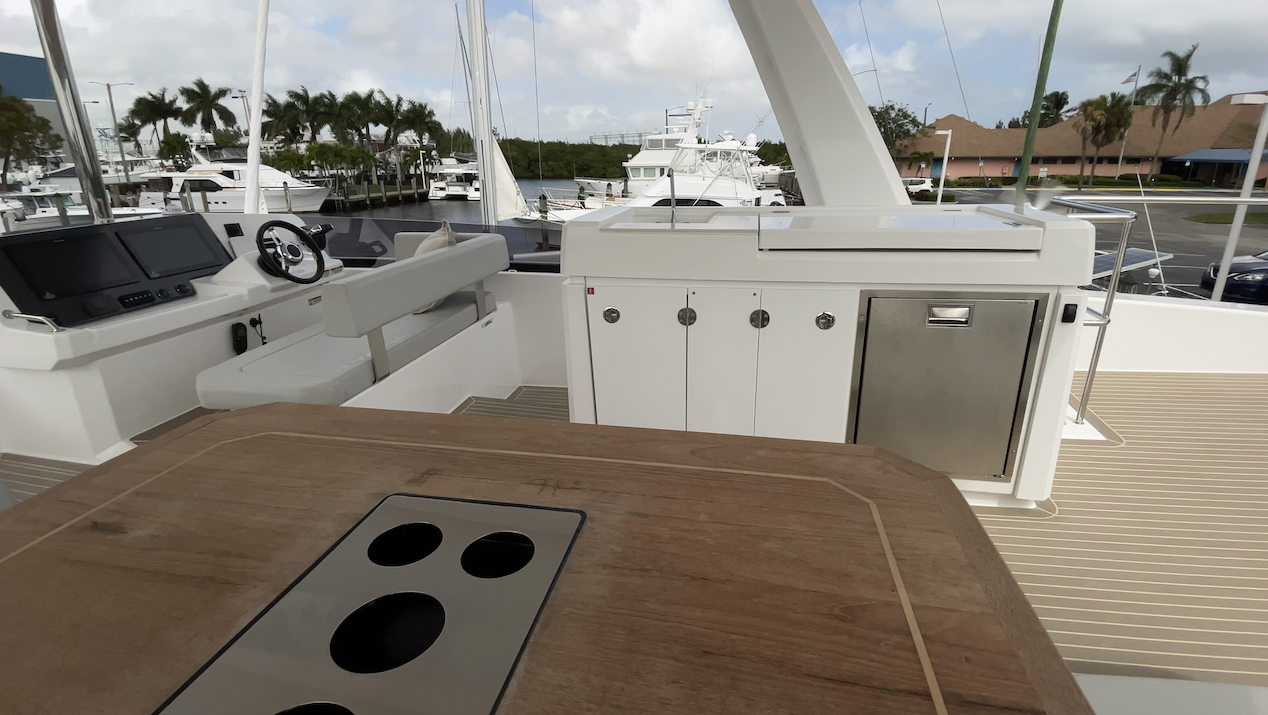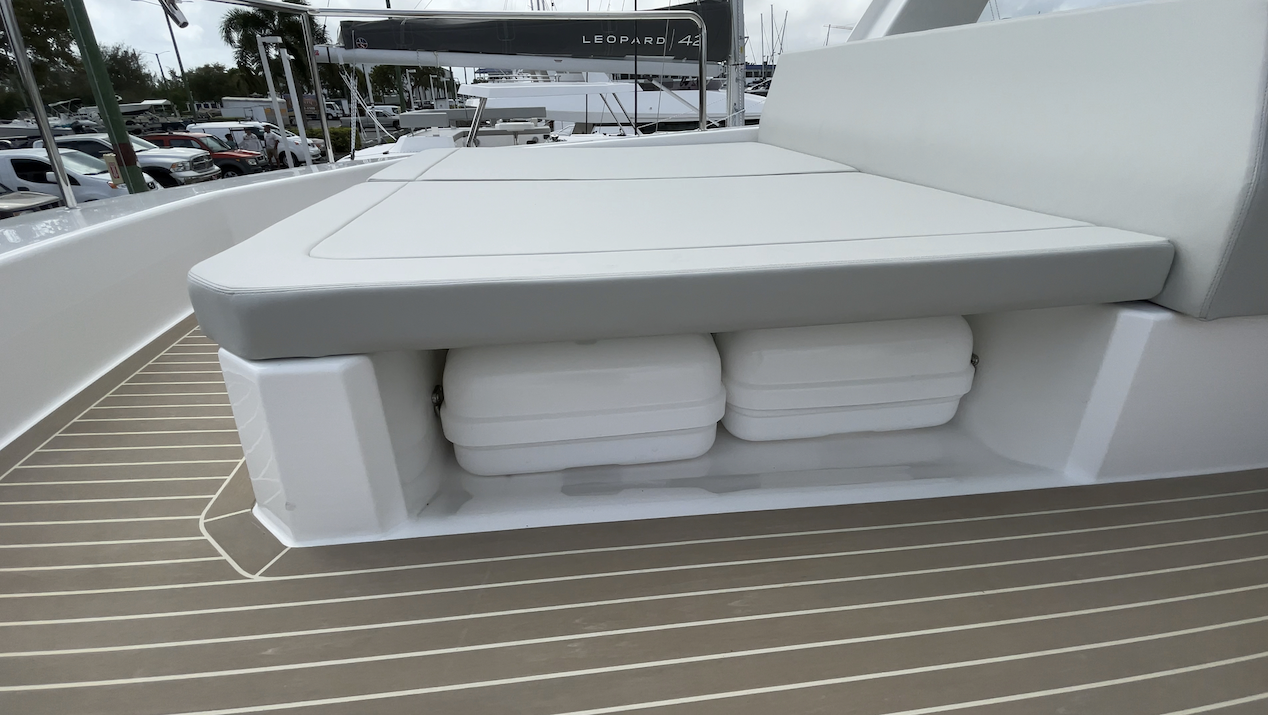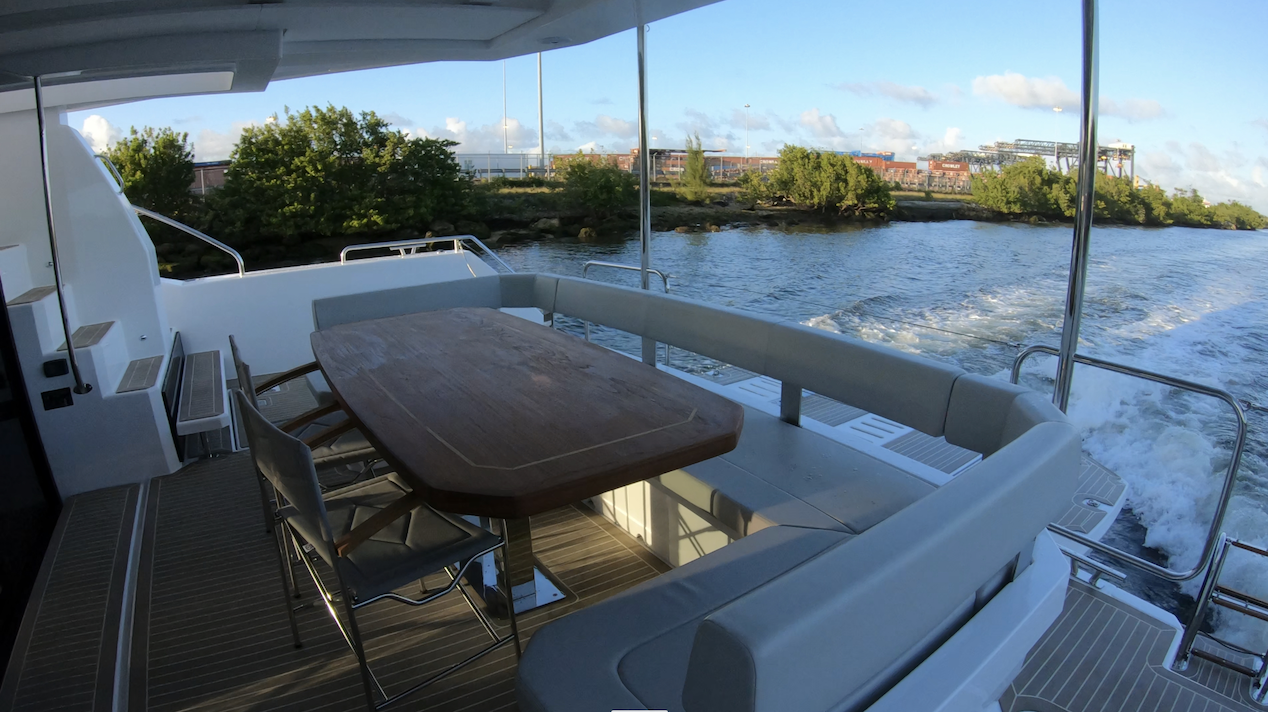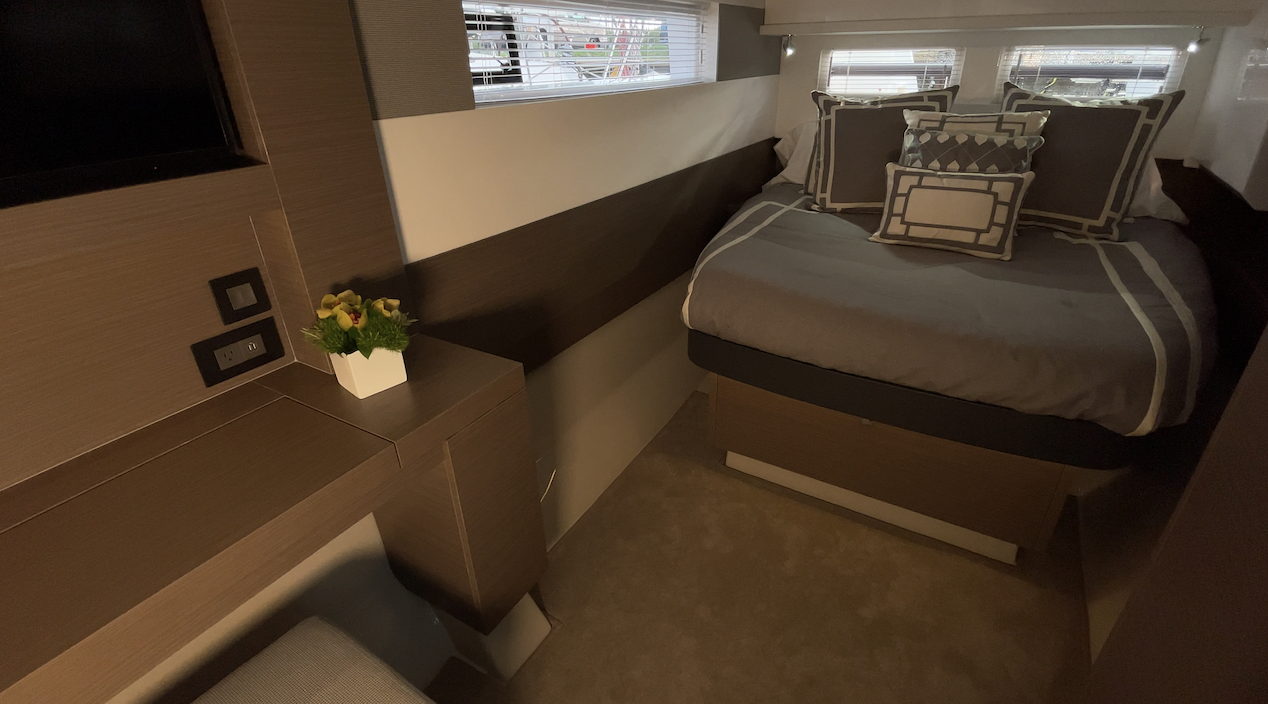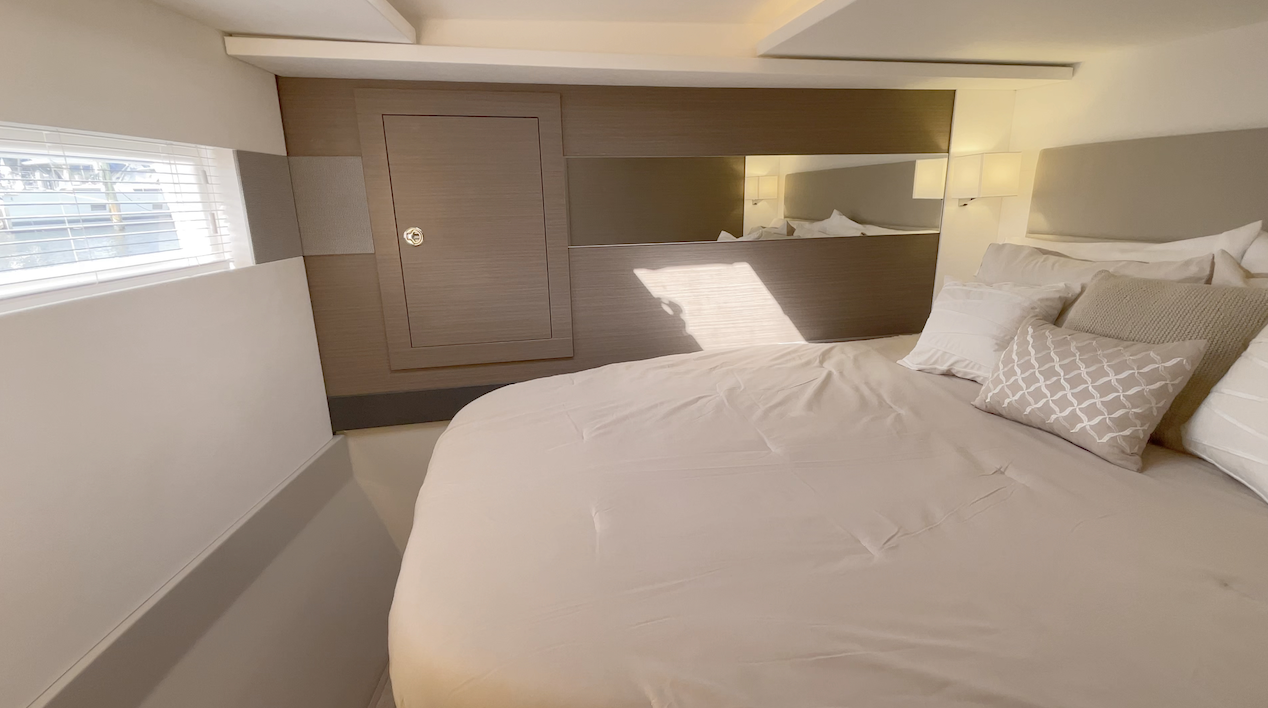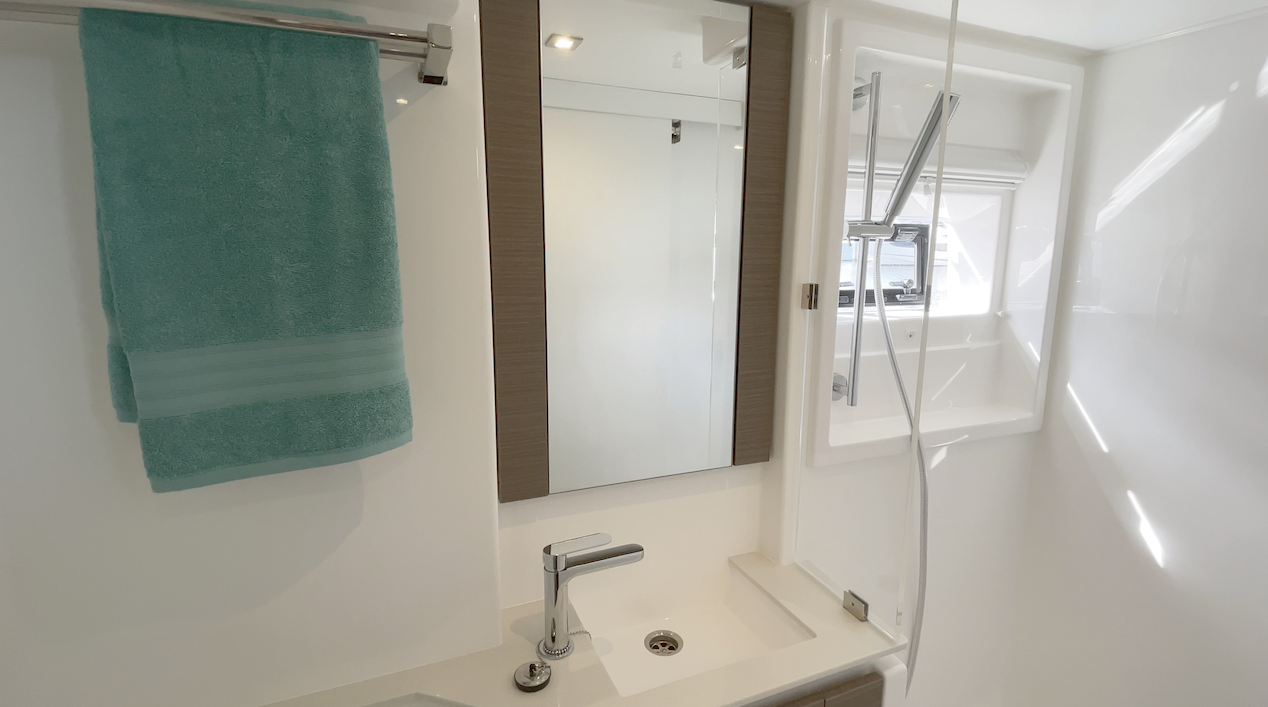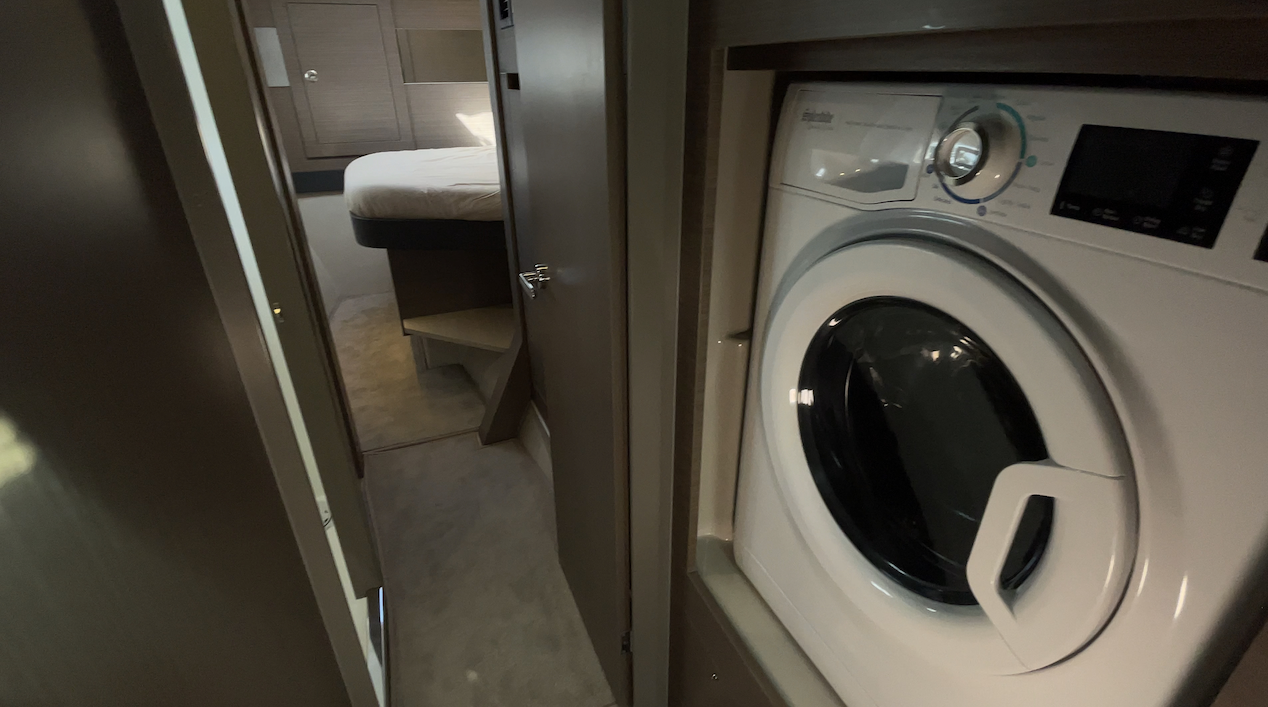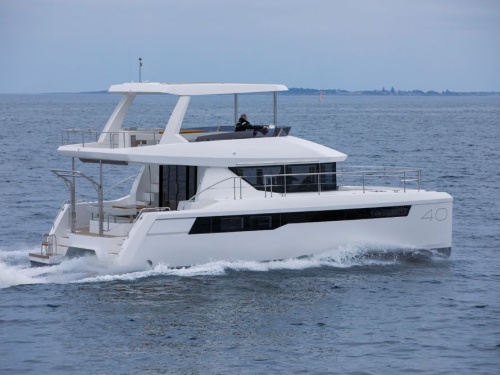Access More Boat Tests
Already have an account? Login
Leopard 46 Powercat (2022-)
2 x 370-hp Yanmar 8LV370
Brief Summary
The mission of the Leopard 46 Powercat is simple and clear cut — "to provide pure comfort and performance compared to the best of its competitors." After closely inspecting and driving this new yacht, we can wholeheartedly say it’s mission accomplished.
Test Results
| RPM | MPH | Knots | GPH | MPG | NMPG | STAT. MILE | NM | dBa |
|---|---|---|---|---|---|---|---|---|
| 550 | 3.6 | 3.1 | 0.5 | 7.9 | 6.9 | 3472 | 3019 | 58.8 |
| 1000 | 5.9 | 5.1 | 1.2 | 4.9 | 4.2 | 2145 | 1865.6 | 59 |
| 1250 | 7.4 | 6.4 | 2.1 | 3.6 | 3.1 | 1589 | 1381.4 | 60 |
| 1500 | 8.9 | 7.7 | 3.5 | 2.5 | 2.2 | 1113 | 967.7 | 65 |
| 1750 | 10.1 | 8.8 | 5.3 | 1.9 | 1.7 | 847 | 736.2 | 65 |
| 2000 | 10.7 | 9.3 | 7.9 | 1.4 | 1.2 | 600 | 521.6 | 65.2 |
| 2200 | 11.7 | 10.2 | 11.2 | 1 | 0.9 | 462 | 401.6 | 66.4 |
| 2400 | 12.5 | 10.8 | 14.5 | 0.9 | 0.7 | 378 | 328.6 | 68 |
| 2600 | 14.6 | 12.7 | 17.2 | 0.8 | 0.7 | 372 | 323.7 | 70.1 |
| 2800 | 16.3 | 14.2 | 19.4 | 0.8 | 0.7 | 370 | 321.5 | 71.1 |
| 3000 | 19.3 | 16.8 | 22.5 | 0.9 | 0.7 | 378 | 329 | 71.8 |
| 3200 | 21 | 18.2 | 26.5 | 0.8 | 0.7 | 348 | 302.5 | 74.1 |
| 3400 | 23.4 | 20.3 | 31 | 0.8 | 0.7 | 331 | 288.3 | 75.2 |
| 3600 | 25.1 | 21.8 | 36.1 | 0.7 | 0.6 | 306 | 265.9 | 75.8 |
| 3700 | 25.3 | 22 | 38.7 | 0.7 | 0.6 | 288 | 250.5 | 76 |
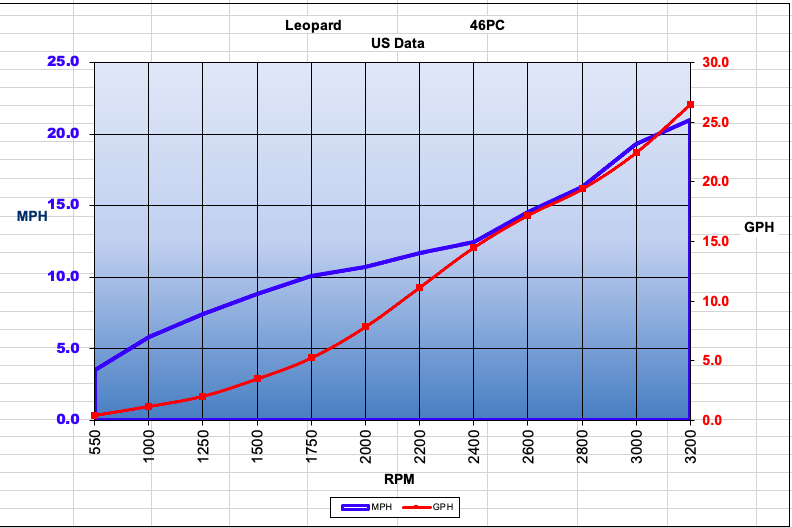
Specifications
| Length Overall |
46' 4" 14.13 m |
|---|---|
| Beam |
24' 1" 7.34 m |
| Dry Weight |
36,945 lbs. 16,757.97 kg |
| Tested Weight |
40,497 lbs. 18,369.13 kg |
| Draft |
3' 1" .94 m |
| Bridge Clearance |
18' 6" 5.64 m |
| Fuel Capacity |
489 gallons 1,851.06 L |
| Water Capacity |
185 gallons 700.3 L |
| Total Weight |
40,497 lbs. 18,369.13 kg |
Acceleration Times & Conditions
| 0 to 30 | 12.4 seconds (0 to 20) |
|---|---|
| Props | 584mm x 595mm x 4 |
| Load | 3 persons; 50% fuel; full water; 50 lbs. gear |
| Climate | 80 deg.; 68 humid.; winds: 15-20; seas: 2-4 |
Engine Options
| Tested Engine |
2 x 370-hp Yanmar 8LV370 |
|---|---|
| Std. Power |
2 x 250-hp Yanmar |
| Opt. Power |
2 x 320-hp Yanmar 2 x 370-hp Yanmar |
Captain's Report
Leopard 46 Powercat: Big Package in a Smaller Footprint

Captain’s Report by Capt. Steve
Mission
By taking the design cues from the 53 Powercat, the new 46 becomes the second in the fourth-generation series from Leopard. That said, she has all the latest features and there’s no feeling of being cramped, as when other builders try to fit 10 lbs. (4.54 kg) of boat in an 8-lb. (3.63 kg) container. This Leopard 46 Powercat is comfortable and functional.
Major & Distinguishing Features
- Based broadly on the award-winning Leopard 53 Powercat.
- Hullside window is a full-length rectangular shape to allow different opening portlight configurations.
- Vertical coach roof windows allow for easier fitment of forward cockpit door and are flat, toughened glass for optimum optical clarity.
- New matte beige finish on galley locker doors and some countertops (in place of gloss white).
- New integrated backsplash around galley worktop.
- More indirect lighting.
- Larger cabins provide wide bunks that are comfortable and accessible from the side along with increased floor space.
- Separate Engine Rooms are completely sealed off from living space.
Performance
The Leopard 46 PC has an LOA of 46’4” (14.12 m), a beam of 24’1” (7.34 m) and a draft of 3’1” (.94 m). With an empty weight of 36,945 lbs. (5,600 kg), half fuel, full water and three people on board, we had an estimated test weight of 40,497 lbs. (18,369 kg). With twin 370-hp Yanmar 8LV370s run up to 3700 RPM, our speed top down to 22 knots. Best cruise came into 3000 RPM at 16.8 knots. At that speed, the 22.5 GPH fuel burn translates it into 0.7 NMPG and a range of 329 nautical miles, all while still holding back a 10% reserve of the boat's 489-gallon (1,851 L) total fuel capacity. In acceleration tests, we reached 20 MPH in 12.4 seconds.
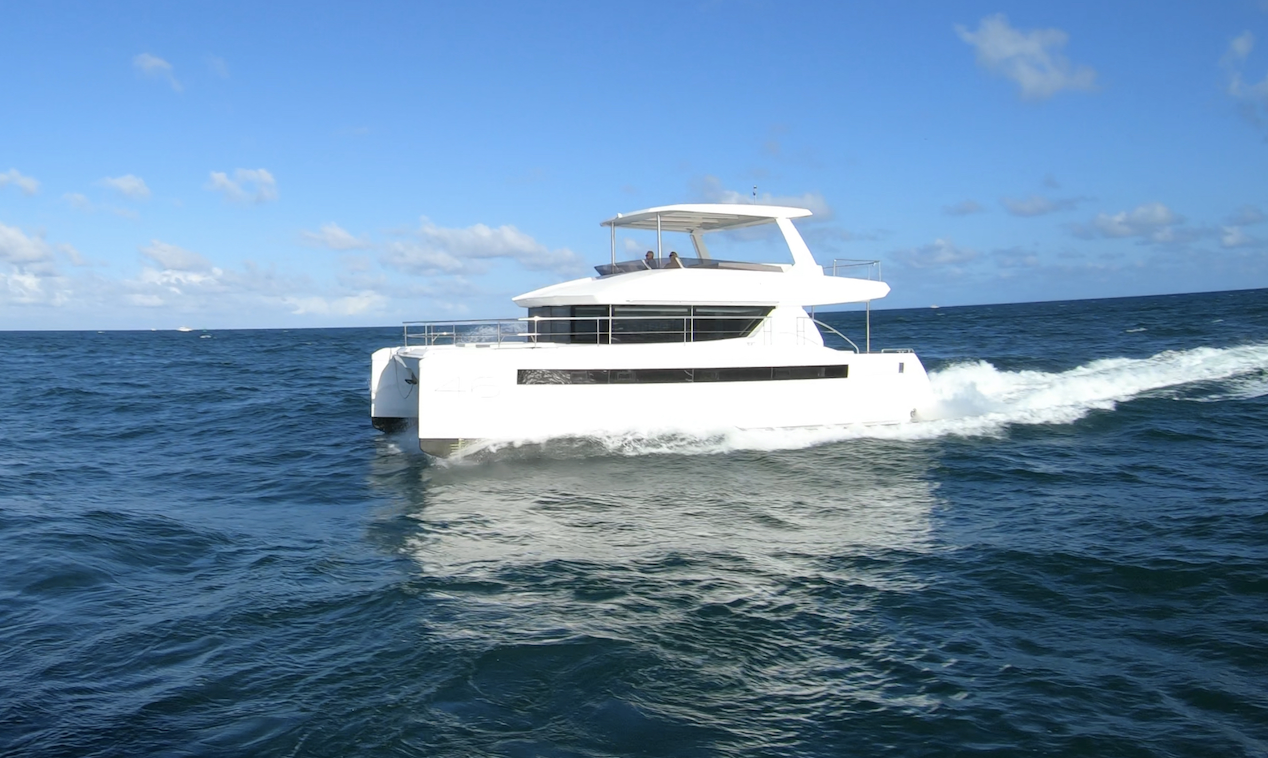
Handling
I found this to be a fun boat to drive. We didn’t have ideal conditions but still got it up to top speed, so we got some good real-world numbers. I got a good feel for how she handles and I was impressed. Going into a head sea, there wasn't so much of a “sneeze” effect as she was taking spray over the bow from what I believe to be the spray rails because the spray was coming from the sides rather than the front.
Going into a beam sea, she was taking spray from the side but that's to be expected. Once the waves would hit the side of the boat they create spray, wind picks it up and then takes it onto the boat, so no points are taken for that. Going down a following sea, I expected that the boat was going to get pushed around from side to side from the waves coming up behind us, but that did not happen. Nor was there any tendency for the bow to stuff itself into the forward wave. It would come into the wave in front of us, slice through it with the narrow bows and create enough buoyancy to come up and over it. It was surprisingly comfortable and I had no problem with the desire to add speed. I didn’t find that there was a sweet spot in speed that was more comfortable than others, it was just comfortable across the spectrum.
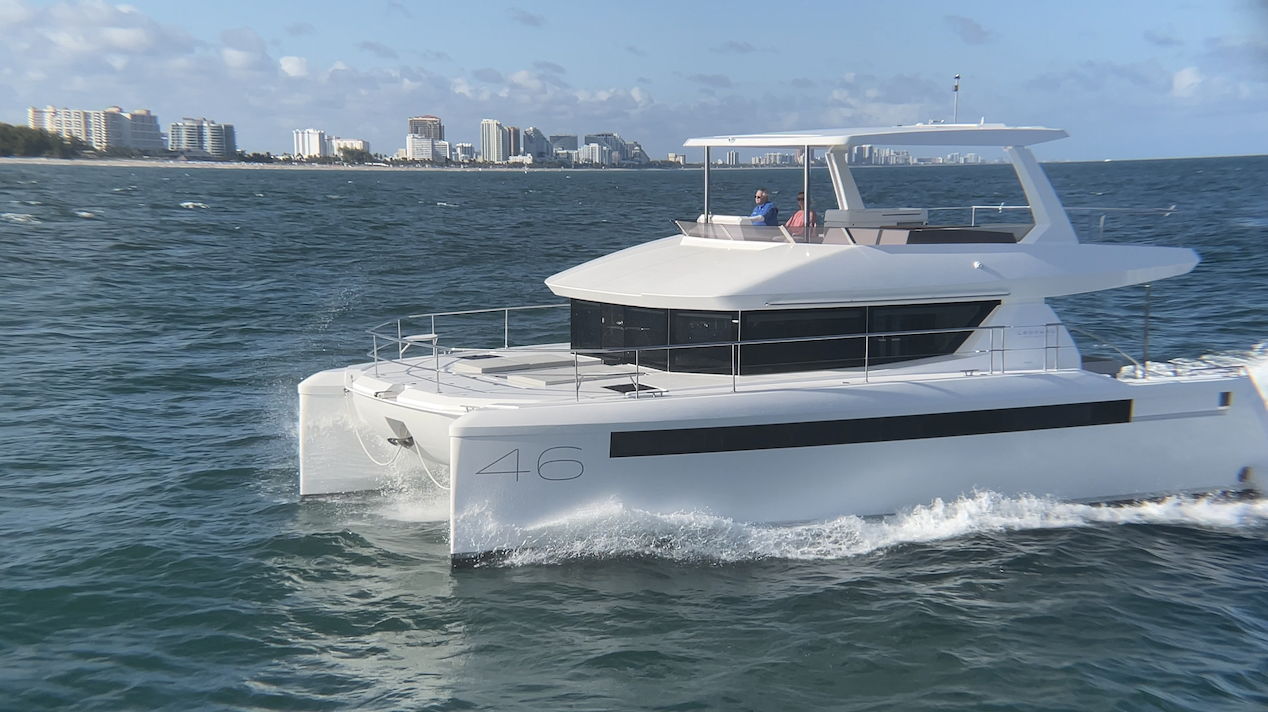
Engines/Engine Room
The engine compartments are accessed from the aft deck, leaving them aft of the sleeping quarters and separated by thick soundproof bulkheads. Of course, the two compartments are much the same with subtle differences, but let's start with the starboard side.
There’s heavy soundproofing on the underside of the hatch that also includes two support struts and gasketing all the way around. As with the bow hatches, there’s a channel going all the way around the perimeter of the entry directing water to a drain and overboard. Engine options start with the standard 250-hp Yanmars and go to 320-hp ($8,676) or these 370-hp 8LV370 Yanmars ($23,066). There's room to get easy access all the way around the engine. There are two engine-start batteries here.
To the port-hand side, there's easy access to the fuel strainer and the raw water strainer. Aft there’s a huge compartment that also gives us easy access to the steering gear. To the starboard bulkhead, there’s the exhaust and the water intake. Both hoses come up and curve down so that we don't get water backfilling into the engine... nice touch there. Everything is double clamped and I notice the sharp edges of the clamps are all protected on the ends.
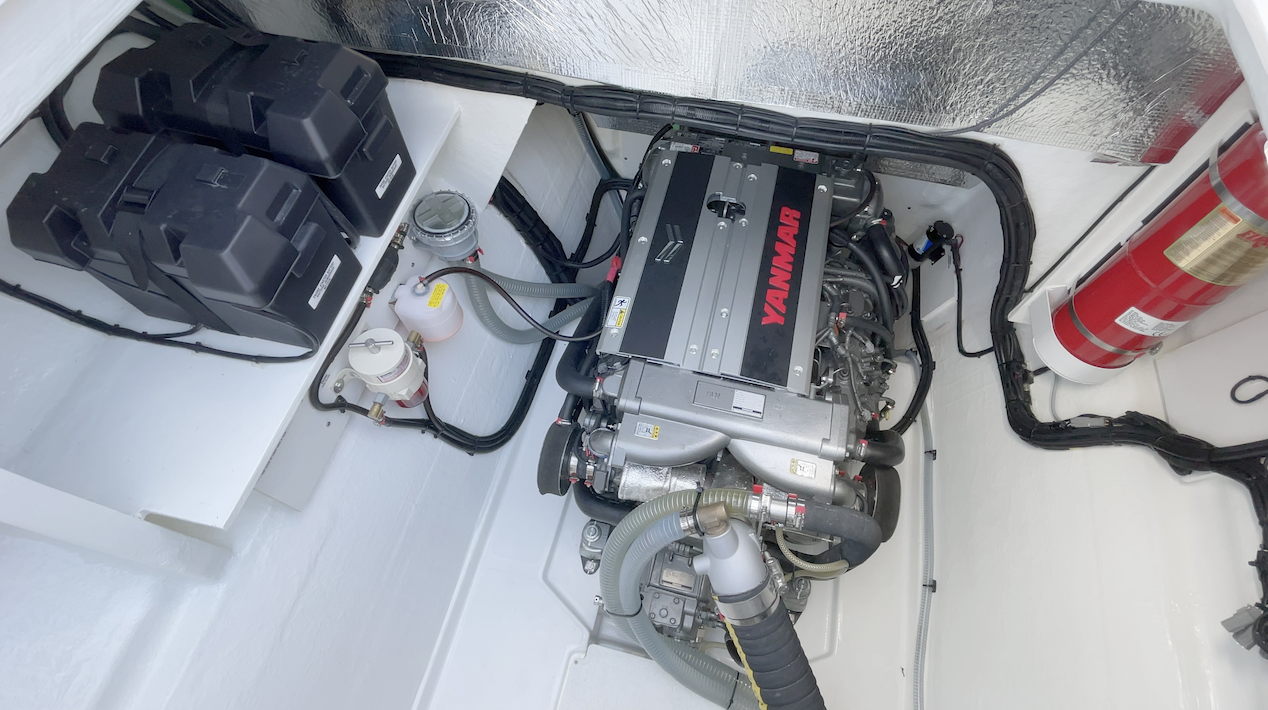
The port-side compartment is a nearly identical setup. Again, there are two engine-start batteries so that's interesting. It's a dual-engine start battery system on both sides. This one also has a generator start battery. The generator is located just behind we can go with a 9 ($46,260) or 12 kW ($53,669) generator. Both engines are driving straight shafts, with no V-drive transmissions.

Boat Inspection
Interior
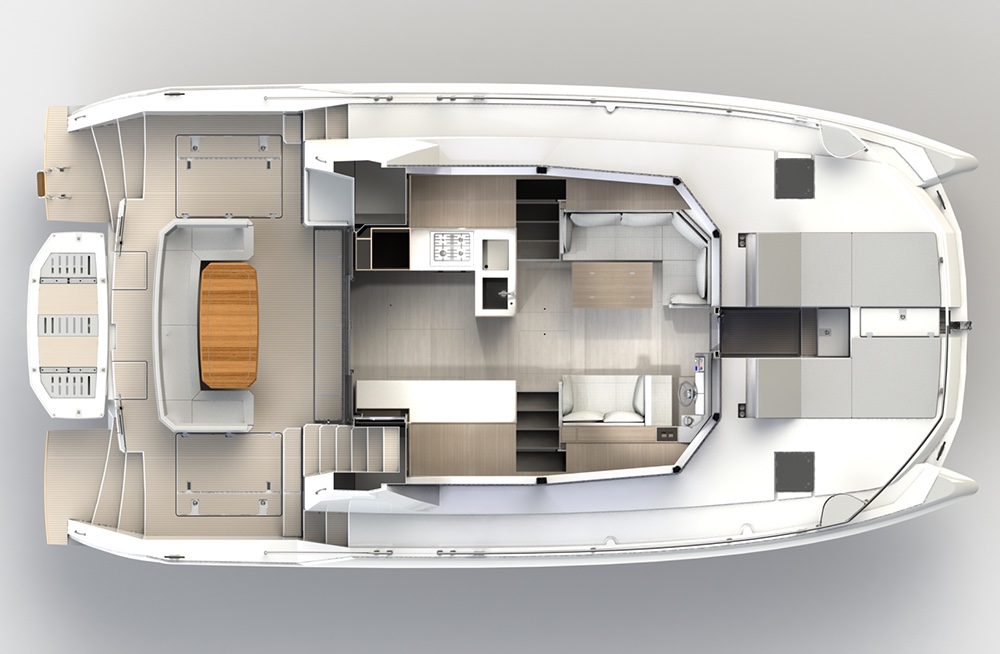
As we transition to the interior, both of the stainless-steel framed glass doors slide open to just over 4’ (1.22 m) wide. Once we get inside there’s an immediate feeling of open space and lots of natural light. The design cues from the 53 immediately become apparent as we look at the interior of the 46. She has the same upgraded fit and finish, new materials and air conditioning overhead vents that cool the room evenly. Leopard has done a nice job of opening the space and significantly maximizing its usability. More important is that the entire deck is on a single level from the stern to forward windows.

Galley
The galley is located aft and to port. It includes a full-size domestic-style refrigerator, which any liveaboard will tell you is an amazing addition to a boat of this size. Other notable features include an induction cooktop, convection microwave and plenty of counter space. There’s a dish drying bin so for couples with only two place settings, the dishes can be done quickly and placed here rather than using a dedicated dishwasher.
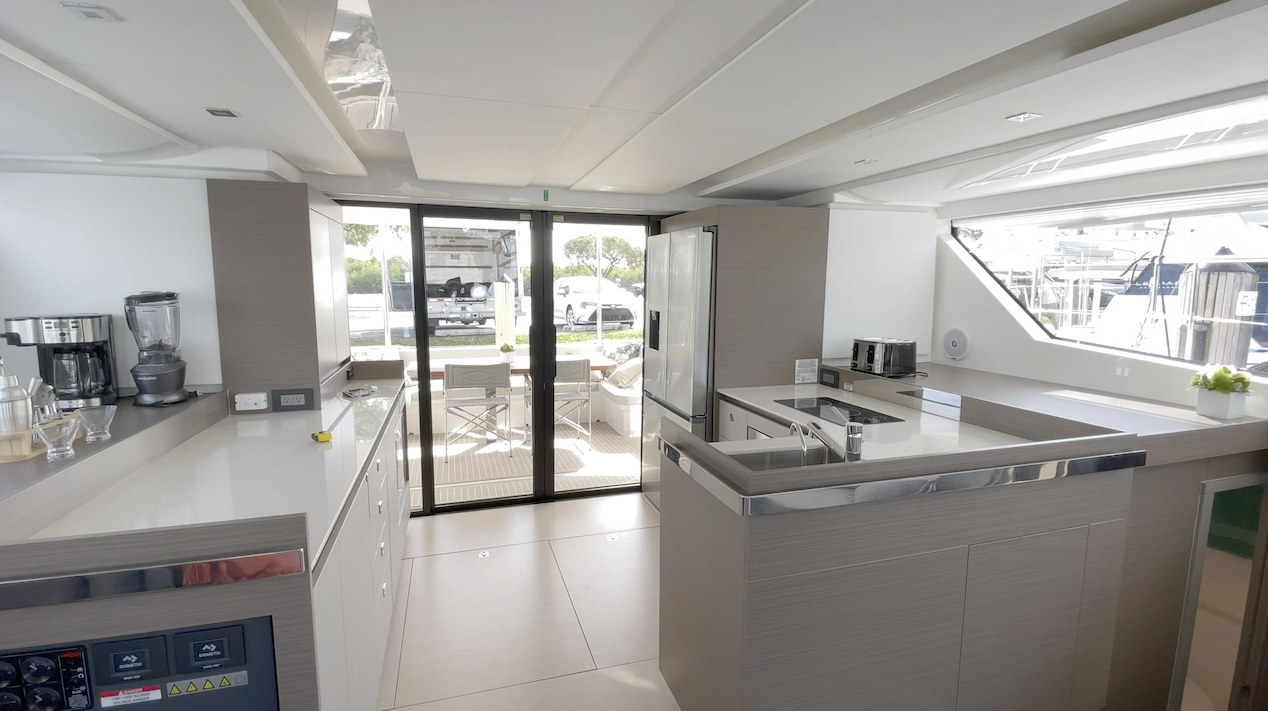
Salon
The salon features opposing seating with an L-shaped sofa to port and a loveseat to starboard. There’s an option to put a high/low table in front of the sofa to create an indoor dining area. Otherwise, there’s a coffee table with beverage holders and dining is moved to the aft deck. Surrounding windows bathe the area in natural light and they come down low enough to have clear sightlines out to the horizon from the seated position. Underneath all the seats is storage. Behind the starboard loveseat is a 50” (127 cm) TV ($2,883) on an electric lift.

Helm
Two 12” (30.48 cm) multifunction displays populate the panel. In addition to showing all our charts, radar functionality and depth sounder, etc… we can also have all our switching and controls for interior and exterior lighting. To the left side is the Raymarine autopilot and down below is a remote control for the autopilot ($1,623) that we can disconnect and carry around with us. There's a Fusion stereo ($4,740) below and to the left. Digital engine controls are over to the righthand side along with a large Raymarine VHF. Just above that, the engine start/stops. The steering wheel is mounted to a tilt base. Missing from the lower helm is the bow thruster stick.
The seat, at 30” (76.20 cm), isn’t really double wide but let's call it seat-and-a-half width. It's in a fixed position. I'd like to see Leopard use a seat that has a flip-up bolster to provide standing room at the helm.
Bow
There’s a forward door that is the favorite of Leopard owners. It gives quick access to the bow and when combined with the open aft doors, it provides wonderful ventilation.
Otherwise, there's easy access to both side decks and because we have a symmetrical layout they both measure in at 34” (86.36 cm) wide. Rail height comes up 29” (73.66 cm, exceeding ABYC standards. There’s an opening gate in the rails to both sides. A 12” (30.48 cm) midship cleat is one of three cleats to each side, plus there’s another pair at the bow.
The wide beam is again put to good use with lounges to both sides of the bow companionway. Additional seats are integrated into both sides of the bowrails. At the stairs, there's a washdown connection hose. The top step lifts to provide storage for the propane bottles if that option is chosen for the galley. It’s self-draining so can also serve as a cooler.
A welcome feature of the two flanking sunbeds is the ability to put them in the chaise lounge position, but only one. Simple strips under the support would allow for multiple levels of incline. There are integrated stainless steel cupholders. Ahead and to the port side of the ground tackle is a large and deep compartment for storing these cushions out of the way when they're not in use. Leopard's finish work is highlighted by the hatches being finished on the underside and both are held open by gas-assist struts. Gaskets surround the perimeter and around the compartment opening is a channel that directs water to a drain and then overboard. Surrounding protection is provided by 25” (63.5 cm) high rails that slightly exceed ABYC standards.
Under the hatch in the center of the bow, there’s a Lewmar windlass leading through a chain stopper and going out to the roller just underneath the deck. There's another roller on top of the deck so we could have a dual anchor setup. The remote control is right alongside plus there's an additional cleat. There's a quick hose connection at the companionway just behind so that we can hose the ground tackle off as it's coming aboard. There's a bridle set up ($559). We already mentioned that the door to the bow is every Leopard owner’s favorite feature. From an operational standpoint, it's mine too because it gives easy access to the ground tackle from the lower helm.
Flying Bridge
Another exterior social zone up in the flying bridge. There’s C-shaped seating surrounding a solid wood table on fixed pedestals. Directly across is a flybridge galley to the starboard side. It includes a covered electric grill, and we’d like to see a cutoff switch to deactivate the grill when the lid is closed. There’s a refrigerator underneath and plenty of storage. Next to the grill is a covered sink and I'm happy to see that there's dedicated storage for the cover. There’s an aft sunbed with storage underneath for life rafts. There’s an additional forward-facing seating area so that while underway guests can accompany the captain alongside. All this is underneath the substantial hardtop with 6’10” (2.08m) of headroom. There are perimeter tracks to support an enclosure.
Helm
The flybridge helm has the same dual 16” (40.64 cm) displays. Additionally, there’s a Fusion stereo remote, electrical switches and charge ports. The steering wheel is mounted to a tilt base. There’s also a Yanmar display and autopilot controls. And this time there is a bow thruster control.
Aft Deck
The last exterior social zone is the aft deck, which is a pleasant place to gather. C-shaped seating surrounds a solid wood table on two fixed pedestals. It’s not up against the aft rails, so it provides full walkaround access and entry to the center platform just behind. The overhead is 6’8” (2.03 m) off the deck.
Back to that platform. It’s clearly not your average platform. Leopard has devised an innovative way to lower this swim platform on a cantilever design causing it to come away from the transom. In that manner, a tender can be deployed much easier. It includes integrated cradles and rings to secure the tender.
Fixed swim platforms are to both sides. The one to port has a substantial reboarding ladder with high rails.
Lower Deck
Master
In the three-stateroom/three-head layout, the master is to the starboard hull.
The berth is aft and has two aft windows plus a large hullside side window with an opening portlight, so there’s a lot of natural light pouring into this cabin. The berth measures 88” x 64” (223.52 cm x 162.56 cm). Overhead clearance 6’4” (1.93 m), which gives us 4’ (1.22 m) over the berth. The hull sides come down alongside the berth so there's a narrow entry but an entry nonetheless. A hanging locker adds extra storage.
Just across there's a desk/vanity with an ottoman that also adds storage. Just above is a 40” (101.6 cm) TV.
As we proceed forward, there is a companionway door to close this whole area off. Just in front of that is even more storage. Dual doors for a hanging locker are across to starboard of the entry.
Master Head
The head is fully forward and consists of two compartments. First are the sinks and the electric flush toilet. Over the sink is a large mirror with a semi-translucent perimeter strip and concealed lighting activated by a touch switch integrated into the mirror.
His and her sinks have storage underneath. Across is another lengthy hullside window with an integrated portlight. Just ahead is a separate shower space. There’s a hanging shower wand and additional storage fully forward.
VIP
Two cabins are to the port side with the VIP being forward. In a bit of “out of the box” thinking, Leopard mounted the 81” x 63” (205.74 cm x 160.02 cm) berth athwartships in the bow. Usually, we see the berth jammed in, leaving no room on either side. This clever solution eliminates that. It's elevated so we're not losing any of that sharp entry to the bow. There's storage forward and a large drawer underneath the berth. Another hullside window with an integrated portlight adds to the natural light. Storage continues just outside with shelves and a hanging locker. Just aft is an ensuite with a separate walk-in shower, sink and head. An opening portlight adds ventilation to supplement an electric vent fan. Outside the door is a combination washer/dryer.
Guest
The guest stateroom is fully aft. The berth measures 80” x 67” (203.2 cm x 170.18 cm). There’s 6’6” (1.98 m) of headroom that leaves 4’1” (1.24 m) over the berth. Leopard added a nice storage solution with a drawer underneath the berth. Shelf space is along the sides and there is a hanging locker behind the door. As with the other staterooms, there’s plenty of natural light from a lengthy hullside window with an opening portlight and two more windows at the transom.
This stateroom also has its own ensuite with a mirrored cabinet for storage. There's a sink recessed into the counter with storage underneath. There's another walk-in shower with an opening portlight for ventilation and another vent fan.
In the four-stateroom layout, this portside layout of two staterooms is repeated to the starboard side.
Options to Consider
- Carpets in cabins and corridors - $4,283
- Carpets in the main salon - $1,273
- Full-length mirrors 4 cabin/3 cabin - $1,687/$1,267
- Interior salon blinds - $8,377
- Raymarine Base Pack: Includes VHF (Multizone with AIS receiver) at the internal helm & additional VHF handset at flybridge helm, p70s autopilot display at internal and p70Rs autopilot display at flybridge helm, AXIOM XL16 Multifunction display in lieu of AXIOM7 Multifunction display at Helmstation. With retractable depth transducer. ($20,743)
- Additional AXIOM XL16 Multifunction display with WiFi at flybridge helm. ($11,024)
- Digital radar ($4,635)
- Rearview camera ($1,196)
- Forward view camera ($1,398)
- 110V Shore power pack: Includes 2 x 30A port and 2 x 30A stbd shore power inlets with 2 x heavy-duty 50ft shore powerlines, AC switch panel, 5000W inverter/charger (in lieu of standard inverter 3000W), Battery management system allowing monitoring on Multifunction display, AC outlets in cabins, salon and galley. ($1,760)
- Four additional AGM house batteries (210Ah) 8 Total. ($5,875)
- Solar panels 150w each fitted to hardtop - (6) ($13,941)
Price Range
The Leopard 46PC has a base price of $969K as of this writing. Fully loaded, she’ll come in at $1.4m.
Observations
Overall, I was very impressed with the 46 PC. she has excellent handling characteristics, particularly in the less-than-ideal conditions we encountered, and she's easy to handle around the dock. Inside, Leopard found a good balance between keeping all the features and nuances of the 53, without compromising on space.

